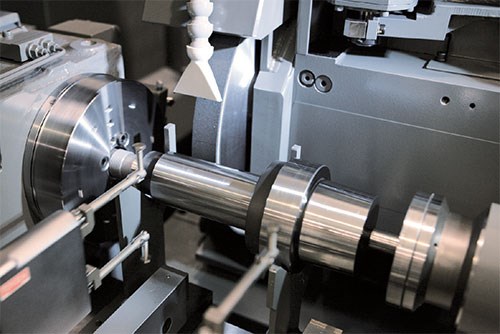Labor Savings in Grinding
Representatives of a grinding equipment supplier comment on how this critical process can be made more efficient.
Share





Grinding is a high-stakes process. By the time a production part reaches a grinding machine, generally that part has undergone significant machining already. The part going to a cylindrical grinder, for example, likely has already spent time on a lathe. If something should happen during the grinding step that results in the part being scrapped, then all of that machining investment is lost—the turning as well as the grinding. A vital requirement of grinding is, therefore, to safeguard the value that has already been added to the part.
However, employees able to oversee this high-stakes process are becoming scarce. As difficult as it is to find skilled machining employees in general, finding skilled grinding employees is more difficult still. At the same time, shrinking lead times are driving many companies to bring grinding in-house. Manufacturers that once would have sent grinding work to a contractor now can’t afford the time to coordinate with an outside supplier. That means facilities that have not performed grinding for a long time are ramping back up this capability—and seeking those scarce employees.
Toyoda Machinery USA supplies production grinding machines. The company’s Shane Farrant, national product manager, and Steve Earley, proposal engineering supervisor, routinely help manufacturers respond to these grinding-related developments. They say automation, in some fashion, is typically the way to achieve productive and reliable grinding when skilled labor is in limited supply. In grinding, that automation takes particular forms.
In-process gaging, they say, is one of the most accessible ways to reduce the need for human intervention in the grinding process. While gaging is typically thought of as an inspection tool, in-process gaging on a cylindrical grinding machine is a productivity tool. Automatic gaging of the workpiece, with measurements sent to the grinding machine’s control, allows the machine to respond to measurement trends resulting from the wheel’s changing diameter. With the process changing offsets on its own to maintain consistency, the wheel might not have to be dressed as often, saving both cost and time.
An even more transformative way to think about reducing the need for labor in grinding is with a universal grinding machine, they say. A universal makes it possible to switch between multiple grinding wheels within the same setup. As a result, ID and OD grinding can be performed on the same machine, not only saving time and attention, but also assuring concentricity between these operations. Separate wheels also can be used to combine rough grinding and finish grinding in one cycle on one machine, speeding the grinding process overall. While a CNC universal grinder is expensive relative to simpler machines, the potential for efficiency gain and cost savings is high.
They say one way to improve efficiency that is not the answer in many applications is switching to a more expensive CBN wheel. On hard materials, CBN can save time and effort because the CBN wheel won’t break down as fast as a conventional wheel. Thus, the need for dressing will be reduced. However, the effectiveness of CBN is highly dependent on the workpiece material, a fact that many grinding users don’t sufficiently appreciate. On a soft material that is prone to loading the wheel, the CBN wheel is subject to that same loading. As a result, dressing might be just as frequent with the CBN wheel as with the conventional wheel, albeit now more expensive because the wheel material is CBN.
Related Content
How to Successfully Adopt Five-Axis Machining
While there are many changes to adopt when moving to five-axis, they all compliment the overall goal of better parts through less operations.
Read MoreInside the Premium Machine Shop Making Fasteners
AMPG can’t help but take risks — its management doesn’t know how to run machines. But these risks have enabled it to become a runaway success in its market.
Read More6 Machine Shop Essentials to Stay Competitive
If you want to streamline production and be competitive in the industry, you will need far more than a standard three-axis CNC mill or two-axis CNC lathe and a few measuring tools.
Read MoreHow to Determine the Currently Active Work Offset Number
Determining the currently active work offset number is practical when the program zero point is changing between workpieces in a production run.
Read MoreRead Next
Registration Now Open for the Precision Machining Technology Show (PMTS) 2025
The precision machining industry’s premier event returns to Cleveland, OH, April 1-3.
Read More5 Rules of Thumb for Buying CNC Machine Tools
Use these tips to carefully plan your machine tool purchases and to avoid regretting your decision later.
Read MoreSetting Up the Building Blocks for a Digital Factory
Woodward Inc. spent over a year developing an API to connect machines to its digital factory. Caron Engineering’s MiConnect has cut most of this process while also granting the shop greater access to machine information.
Read More
































